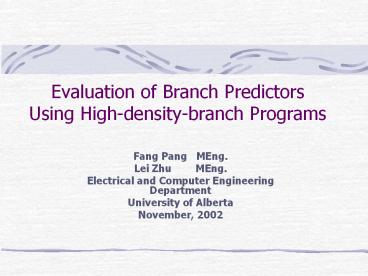Evaluation of Branch Predictors Using High-density-branch Programs PowerPoint PPT Presentation
Title: Evaluation of Branch Predictors Using High-density-branch Programs
1
Evaluation of Branch Predictors Using
High-density-branch Programs
- Fang Pang MEng.
- Lei Zhu MEng.
- Electrical and Computer Engineering Department
- University of Alberta
- November, 2002
2
Introduction
- In this project, we are going to evaluate
different branch predictors for
high-density-branch programs. A C code for Binary
(6,4) encoder and decoder is used as example
program. - Simplescalar tool will be used as the simulation
tool. - The effectiveness of different types of branch
predictors is observed. And the effect of the
size of predictor is observed.
3
Example Program
- The Binary (6,4) encoder takes 4-bit source words
as inputs, reads though the lookup table stored
in the memory, finds out the corresponding 6-bit
code words and exports code words. - All code words are added by random noise and sent
to Binary (6,4) decoder. - The Binary (6,4) decoder takes these 6-bit code
words as inputs, reads through the lookup table,
finds out the corresponding 4-bit source words
and exports source words. And it treats it as an
error if the corresponding source word cant be
found in the lookup table. At the end of process,
it calculates the number of errors and the error
rate. - This program contains high-density branches. Most
of them are random conditon branches.
4
Project Description
- Taken branch, bimodal predictor, 2-level adaptive
predictor and combined predictor are evaluated. - Different size of predictors are compared.
- Multiple function units and multiple ports of
memory are used to support wide issue. - Different caches for data and instructions are
used.
5
- Simulation
- Sim-Outorder will be used to evaluate performance
of different branch predictors. Different size
predictors will be tested and compared.
6
Goal
- Find out the best branch predictor for this
example program. - Find out the relationship between the size of
predictor and its performance.
7
Question
- ???
- Thanks!
PowerShow.com is a leading presentation sharing website. It has millions of presentations already uploaded and available with 1,000s more being uploaded by its users every day. Whatever your area of interest, here you’ll be able to find and view presentations you’ll love and possibly download. And, best of all, it is completely free and easy to use.
You might even have a presentation you’d like to share with others. If so, just upload it to PowerShow.com. We’ll convert it to an HTML5 slideshow that includes all the media types you’ve already added: audio, video, music, pictures, animations and transition effects. Then you can share it with your target audience as well as PowerShow.com’s millions of monthly visitors. And, again, it’s all free.
About the Developers
PowerShow.com is brought to you by CrystalGraphics, the award-winning developer and market-leading publisher of rich-media enhancement products for presentations. Our product offerings include millions of PowerPoint templates, diagrams, animated 3D characters and more.

